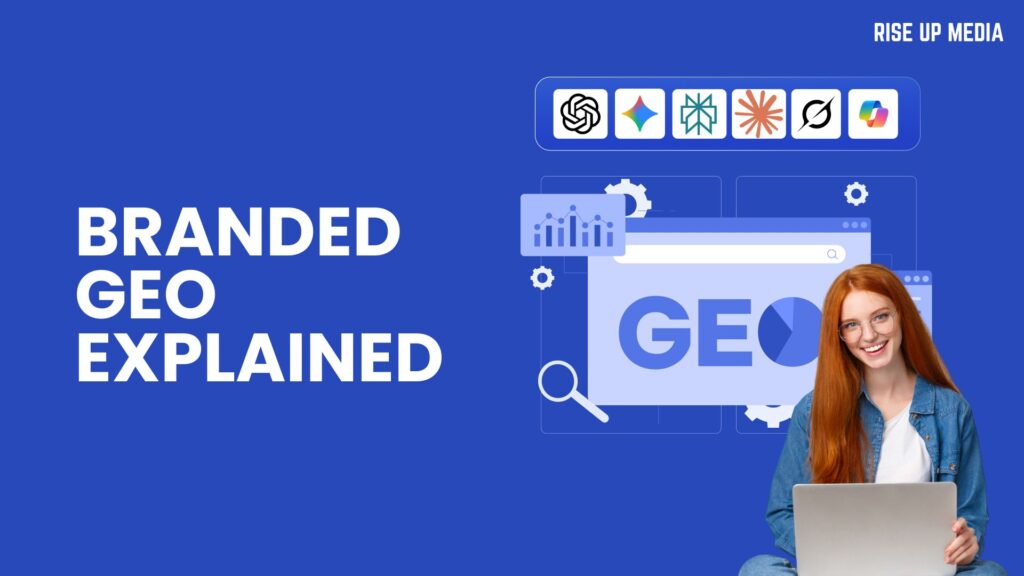Branded Generative Engine Optimization (GEO) is the latest thing brands need to consider as part of their AI Search strategy. It refers to improving the accuracy and quality of what AI says about your brand.
In GEO, your brand’s credibility isn’t just what people say. It’s what AI repeats. Branded GEO ensures that the narrative these systems tell about you is accurate, authoritative, and impossible to ignore.
Read on to learn how you can influence what AI says about your company.
TL;DR
- Branded GEO involves tracking, auditing, and updating your information regularly so AI systems always know the most credible story.
- Generative engines summarize your brand for millions of people. What they say matters more than what you post.
- Bad data creates false narratives, and without verified content, AI fills in blanks with rumors, outdated news, or hallucinations.
- Structured data, strong backlinks, and consistent information keep AI outputs accurate.
What Is Branded GEO?
Branded Generative Engine Optimization is the strategy of shaping how generative AI systems understand, represent, and recommend your brand.
Branded GEO is a piece of Search Everywhere Optimization.
Traditional SEO merges with branding and reputation management, allowing AI search engines like ChatGPT, Perplexity, and Gemini to connect your business with the right locations, audiences, and contexts.
Consistent, location-specific signals across your digital presence (e.g., reviews, citations, local content, and backlinks) power branded GEO. AI systems use these signals to anchor your brand to a real place and community.
Customers are increasingly relying on conversational AI for “near me” answers and local recommendations. Mastering generative engine optimization (GEO), especially location-based branding, helps your brand show up first and show up right.
How AI Shapes Brand Perception (& Why You Should Care)
People are using AI to summarize information from the internet, but these tools also shape it.
Every time a user asks a chatbot for recommendations, explanations, or comparisons, AI systems decide which brands to feature, how to describe them, and whether they seem credible.
That means AI (not ads) is now narrating your brand story.
When someone asks, “What’s the best bank near me?” or “Which digital wallets are the safest?” generative engines pull from existing data to give their best answer.
They’re using reviews, mentions, press, and even user sentiment.
If your brand isn’t well-represented in that ecosystem, you’re invisible in the conversation.

AI-generated summaries, reviews, or comparisons can amplify your reputation or quietly erode it. A single phrase, like “known for slow service” versus “praised for personal attention,” can tilt consumer trust in seconds.
That’s why branded GEO matters! It gives your brand a seat at the AI table, helping machines build confidence around your products and services.
When AI Gets It Wrong: The Brand Reputation Risk
When AI doesn’t know, it guesses. Those guesses can damage a brand faster than any bad press.
Without structured, verified content, generative models pull from a messy mix of old headlines, user forums, and speculation.
The outcome is a reputation shaped by rumor instead of reality.
Here’s what typically goes wrong:
- Hallucinated claims: AI invents details that never existed, like fake partnerships or false shutdowns.
- Outdated data: Years-old controversies resurface as “breaking news.”
- Context collapse: Legitimate updates get twisted into misleading summaries.
- Echo effect: Incorrect AI outputs spread as other models repeat them.
Real brands have paid the price:
- A viral claim by Grok asserted that the U.S. Securities and Exchange Commission (SEC) had dropped its lawsuit against Ripple, a statement later debunked by former SEC attorney Marc Fagel.

Source: Coinpedia
- The Chicago Sun Times and Philadelphia Inquirer both lost trust with readers when they published an AI-generated list of book recommendations that didn’t exist.
- ChatGPT hallucinated court cases that a lawyer relied on to show precedence.
Here’s the hard truth: you can’t correct an AI model mid-conversation.
Once bad data gets baked in, it sticks until the next retraining cycle, which could be months away.
Waiting for OpenAI, Anthropic, or Google to “fix it” isn’t a plan. Owning and structuring your brand’s verified data is the only way to ensure AI tells the truth about you every time it speaks.
How to Build a Branded GEO Framework, Step-by-Step

Branded GEO is about reclaiming control through verified, consistent, and geographically grounded data.
Here’s how to do it:
Audit your AI presence
Ask the same questions your audience does on ChatGPT, Perplexity, Gemini, or Copilot. What’s being said about your project, your team, or your headquarters? Which sources are being cited?
This snapshot reveals what AI thinks your brand is and where it’s guessing.
Identify data gaps and inconsistencies
Cross-check every fact AI mentions against your official materials.
For example:
- Are your leadership bios up to date?
- Is your founding city or jurisdiction listed consistently?
- Does your company’s name appear with the same phrasing across exchanges, press, and listings?
Inconsistent metadata will fragment your brand identity inside AI systems.
Rebuild your content architecture with entity-rich, structured data
Feed AI the details it craves. Use precise, machine-readable structures such as schema markup, Wikidata entries, and verified Knowledge Graph data.

Connect your brand, products, founders, and locations with well-linked entities so generative models can accurately map relationships rather than infer them.
Publish verified information across high-authority sources
AI trusts authority.
Post updates on official domains, recognized media outlets, and platforms that rank high in trust. Examples include CoinDesk, TechCrunch, or Crunchbase for Web3 brands.
Encourage backlinks from partners, investors, and collaborators, or work with an agency to secure placement on third-party sites. Every verified citation reinforces your brand’s digital identity.
Use AI Search-optimized schema and backlinks
You need to teach AI to read your brand’s blueprint. Search engines and generative models rely on structured data to understand who you are and what you do. Here’s how to optimize for AI search:
- Adopt a JSON-LD schema that clarifies your company’s location, founders, product categories, and partnerships.
- Embed local coordinates and organization data that tie your brand to a specific place.
- Get high-trust backlinks, especially those from local or industry-relevant domains.
When done right, this framework turns AI from an unpredictable narrator into a reliable brand ambassador, one that speaks your language, in your voice.
How to Track and Manage What AI Says About Your Brand

AI conversations move faster than traditional search. What’s said today can shape public sentiment tomorrow. Tracking and managing how generative engines represent your brand requires both the right tools and a proactive approach.
Use monitoring tools built for AI
Traditional brand monitoring platforms like Mention, Brand24, and Meltwater now integrate AI content tracking. You can also set up UTM parameters to track clicks that come from generative engines, not just Google.
Prompt ChatGPT, Gemini, and Claude using branded queries to observe how their responses change over time.
Respond strategically to negative AI narratives
Don’t panic-correct every misstep; trace the misinformation back to its source.
If an AI summary misquotes your project or founders, identify which web pages, forums, or datasets the content likely originated from.
Then, publish accurate, verifiable information on high-authority platforms (such as press releases, knowledge panels, or verified blog posts) so AI engines can retrieve the right data in the future.
Stay proactive with reputation management
Schedule quarterly audits to identify new mentions or summaries, and set alerts for key phrases (like your token name, founder, or slogan).
Consistently create accurate, structured content that supports your main narrative. This consistency can help to train AI models and avoid confusion in the future.
The brands that win in this space aren’t the ones who react fastest; they’re the ones who teach AI who they are before anyone else does.
Need to Own What AI Says About You?
AI is playing a significant role in shaping trust. It’s deciding whether you’re seen as questionable or credible.
Branded GEO lets you influence how AI understands, describes, and recommends you.
Structure and consistency matter. You can better understand and control both by frequently auditing your Gen AI presence, filling in missing data, correcting errors, and structuring your content in ways that make sense to AI engines.
If you need help navigating these areas, contact our team today, and let’s get started!
FAQs
How do I audit what AI currently says about my brand?
Start by asking generative engines like ChatGPT, Perplexity, Gemini, and Copilot the same questions your customers would, such as “What is [Your Brand]?” or “Who owns [Your Company]?” Note how each platform describes your brand, which sources it cites, and whether the tone or facts align with your official messaging.
Document discrepancies in product details, leadership names, or locations. Then trace those errors to their likely sources (outdated articles, inconsistent listings, or missing structured data) so you can correct them at the source. This audit becomes your baseline for Branded GEO improvements.




